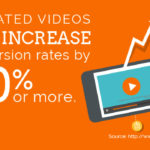Endless hours of research on today’s most effective marketing methods all point to the same conclusion — VIDEO MARKETING IS KING! Whether it be on social media or your website, video marketing increases conversions and provides a strong ROI.

64% of consumers say watching video ads on Facebook has enticed them to make a purchase.
A whopping $13.23 billion were spent on video ads in 2017.
Video ad completion rates have steadily increased year over year.
93% of marketers use video ads in their content marketing strategy, and more than half prioritize videos as a go-to source for increasing traffic to their website and boosting conversions. Even 43% of B2C marketers agree pre-produced video is the most effective form of content. (1)
Even if you’re not investing in video ads, your competitors are, and they are gaining a competitive advantage with each passing day.
There’s no need to think you have to create lengthy videos to increase conversions. Facebook research shows about half of the value acquired from video advertisements is actually secured during the first three seconds. (2) This is why short ads have a such a strong ROI. If you add captions, this can increase view time by as much as 12%, which is quite impressive when you’re talking about ads that are only 30 to 90 seconds long. (3)
How to Improve Ad Strategy With Video Marketing
A strategic video marketing strategy will increase qualified leads. The goal is to publish engaging video content that moves the audience through the buyer’s journey, and ultimately, leads to a sale.
Video marketing is extremely effective thanks to the use of extensive metrics. You can measure view time rates, social media shares, comments, and more and then use your findings to refine your video marketing strategy. A number of best practices can be used to create engaging video content that captures viewers’ attention and lures them to follow your call to action (CTA).
Tell a Story

Finding a way to tell a story in the video that isn’t overly-promotional is essential to connecting with viewers. The correct use of sound, imagery, and animations will evoke emotion and build a strong connection. A video’s story should outline a pain point and then clearly explain how your brand can eliminate it. It should also show what it means to have the problem solved.
Many brands fail to include the “means” part in their animated video ads. They simply detail a pain point and how their product or service can break through that pain point, but they don’t explain what it means to have it eliminated.
Take for example your brand sells DIY home security systems. Your audience can afford to buy equipment but doesn’t want to invest in a monthly service plan. With your product, the customers can customize their own DIY home security system and sync it with their smartphones. There’s no need to sign a monthly service contract and users can view real-time video footage from a mobile device.
All of this information is great, but what does it mean?
It means the audience is saving money, can create a customized security system that meets their unique needs, and is achieving optimal home security protection. Three different pain points are eliminated, but your audience doesn’t know this unless you show them in the video.
Leave a Lasting Impression in 10 Seconds
20% of viewers are going to stop watching your video within the first 10 seconds. This means you have a very short window of time to make a huge impression. Even if they click away, you at least want them to remember your brand. Asking intriguing questions or stating interesting facts is an effective way to magnetize their attention and keep them watching. Any questions or facts should be directly related to the pain point you are claiming you can solve.
Establish Your Value
Integrating video into your ad strategy allows you to establish your brand’s value. Using animated graphics, you can show viewers important stats about your brand, including how many customers you have served and how many continue to do business with you. You can also include stats on product uses and outcomes. Providing visual content to showcase new ways to use your product is an excellent way to educate the audience. This can come in the form of explainer video advertisements.
Sharing testimonials and case studies in video ads lend your brand credibility as an industry leader, which is of the utmost importance. Studies show customer testimonials and reviews heavily influence purchasing decisions. 88% of consumers trust online reviews just as much as they do personal recommendations from their family and friends. (4)
There are five types of testimonials to create when using video to improve your ad strategy. (5)
- Claim testimonials: before-and-after case studies
- Competence testimonials: showcase your expertise and experience
- Character testimonials: substantiate your passion for your brand
- Company testimonials: let the audience get to know your employees
- Combination testimonials: combines all of the above-mentioned testimonials
Optimize Your Video Marketing Content
You must optimize video ads for high rankings. To boost the SEO value of the videos, it’s important to enable embedding as well as host them on your own domain. Both of these tactics improve the likelihood of acquiring links for inbound marketing purposes.
You’ll also need to optimize each video with a detailed description. This ensures search engines have a good sense of what your video is about and who to place it in front of. In addition to descriptions, videos should include relevant tags and titles.
Use Big Fonts
You may not think much about fonts when creating videos because, after all, they aren’t text-based pieces of content. As with any form of content, though, its formatting needs to be optimized for a good user experience, and this includes any font. In fact, all fonts and graphics need to be large. The larger they are, the easier it is for viewers to see them, which is immensely important for viewers watching from a mobile device. Tiny text is going to be difficult to see in a video while being watched from a smartphone or tablet.
The goal is to ensure the viewer can read the text easily so that he or she is not distracted while trying to watch the video. You don’t want the viewer straining to read a caption as this will make it difficult to keep up with what you’re talking about. It could cause the viewer to have to constantly stop and rewind the video, which will inevitably lead to clicking out of the video altogether.
Create Mobile Versions

Shorter Goes a Long Way

A key element to creating effective video ads is to measure each video’s effectiveness. This requires performing A/B testing on both mobile and desktop versions. In doing this, you can pinpoint which versions are providing the strongest ROI. From here, you can refine your video ad marketing strategy to include more of those types of videos.
For example, when creating a 30-second video, make sure to create a 15-second version, as well. Use metrics and analytics to determine which video is resulting in the most sales. You may find the 15-second version is performing much better. You can then adjust the video creation process to not only start producing more 15-second videos but to also test out 10-second versions.
Even a 10-second video can highlight who your target audience is, the product you are promoting, and how to get it. If you happen to have a product or service that’s still in the pipeline, make sure to explain when it will be available and why your audience should care.
Integrate Indirect Pitches
Improving your ad strategy with videos requires explaining how your product benefits the audience. You can start by making a list of your product’s top three real-life benefits and then use graphics, live video, and animations to bring those videos to life. For example: If you sell running shoes, you don’t want to focus too much on a pair of shoes just sitting on the floor. Instead, you’d want to show someone actually running in the shoes.
Even if your video ads don’t lead to direct sales, you are always gaining the advantage of spreading your brand awareness, which is key to generating leads and eventually closing on sales. With this in mind, indirect pitches that aren’t focused on making a sale but rather educating the audience about your product often do far better than direct pitches with a click here to buy now CTA.
Focus On What You Measure
The majority of marketers agree video marketing leads to higher conversions than all other content types. And with consumers demanding more branded video content, this puts your company in a valuable position to leverage video marketing to your fullest advantage. No matter how engaging your videos are, though, they must land in front of their intended audiences at the right time. To ensure this happens, you’ll need to create buyer personas and use metrics and analytics.
Carefully creating buyer personas gives you a full understanding of who your audience is. Detailed personas can be a solid foundation for your entire marketing strategy, not just your video marketing efforts.
When measuring video effectiveness, you’ll start by looking at viewability, completion rates, and levels of engagement metrics. To improve these metrics, add interactive segments throughout various parts of the videos, including CTA overlays. These segments not only provide a better viewer experience, but they also help you determine which segments are staying in view and how many viewers are actually continuing to watch the video after each segment.
Bounce rates are another metric to focus on. Most times, high bounce rates are caused by irrelevant content. This doesn’t necessarily mean your content is irrelevant to your target audience. It could be your videos simply aren’t landing in front of the intended viewers. It could also be that the ads are located on a part of the page that doesn’t correlate with your ad. Using tools that allow you to take advantage of an automatic placement of ads will help eliminate this problem and can improve bounce rates.
The Takeaway

And when compared to plain text, content with video is likely to boost organic search by as much as 50 times. Video is crucial to your content marketing strategy. While only 20% of people will read an entire blog post, 80% will watch a video. There’s no need to be on the fence about integrating video into your ad strategy. Are you ready to start increasing conversions, brand awareness, and lead generation with video in your ads?
Leverage Video Marketing To Increase Conversions Today
Sources
- https://contentmarketinginstitute.com/wp-content/uploads/2017/12/2018_B2C_Research_Final.pdf
- https://www.facebook.com/business/news/value-of-video
- https://www.facebook.com/business/news/updated-features-for-video-ads
- https://www.forbes.com/sites/jaysondemers/2015/12/28/how-important-are-customer-reviews-for-online-marketing/#7defa7361928
- https://www.forbes.com/sites/forbescoachescouncil/2017/07/27/do-you-have-all-five-types-of-testimonials/
- https://www.hubspot.com/marketing-statistics








